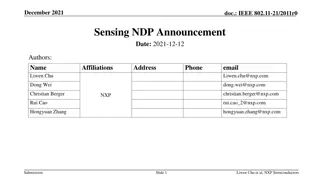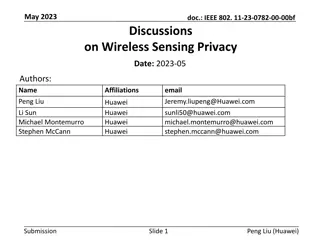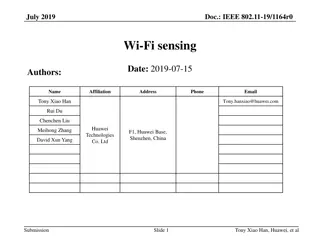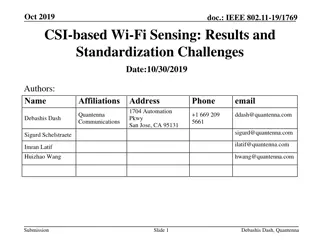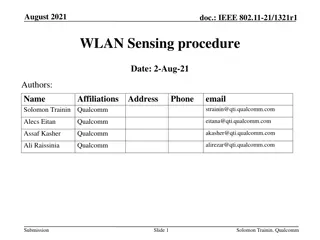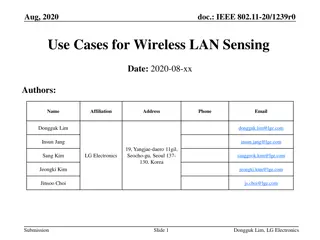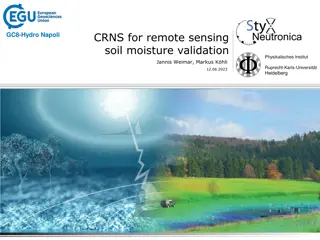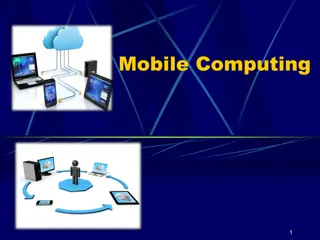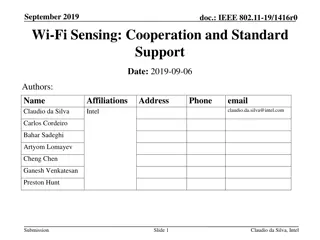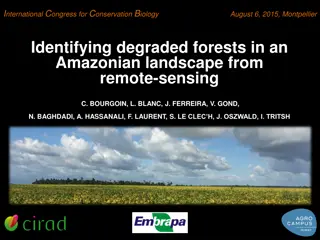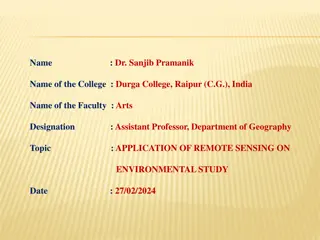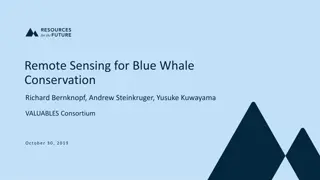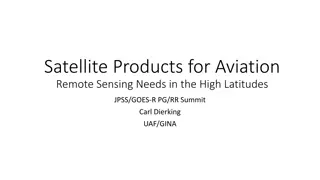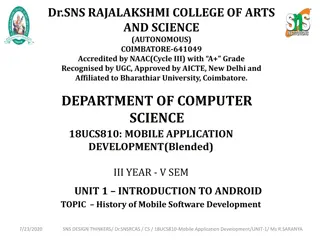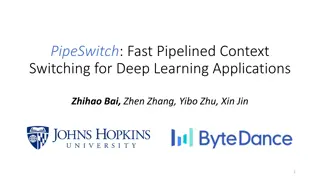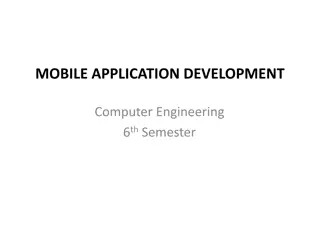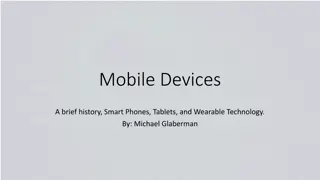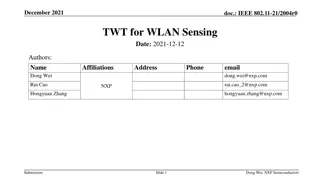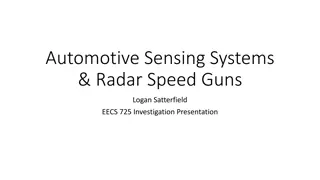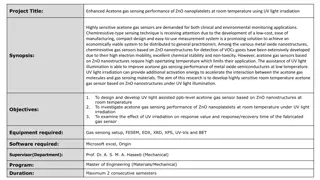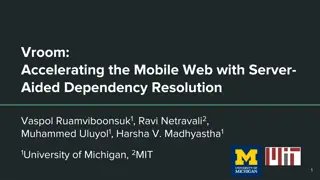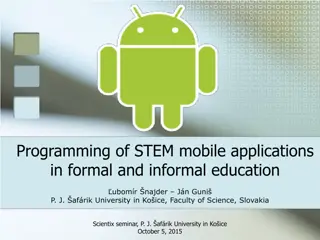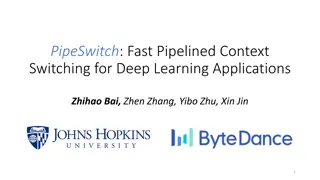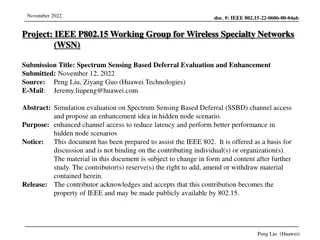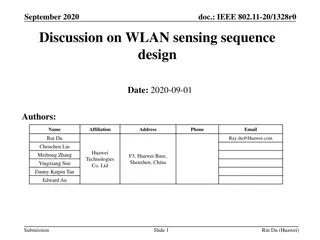Efficient Context Sensing for Mobile Applications
Leveraging correlations between different user contexts, the ACEACE framework by Suman Nath explores energy-efficient continuous context sensing for mobile apps. By inferring expensive attributes from cheaper ones, the system optimizes sensing tasks based on human activities, significantly reducing energy consumption and enhancing overall app performance.
Uploaded on Sep 26, 2024 | 0 Views
Download Presentation

Please find below an Image/Link to download the presentation.
The content on the website is provided AS IS for your information and personal use only. It may not be sold, licensed, or shared on other websites without obtaining consent from the author. Download presentation by click this link. If you encounter any issues during the download, it is possible that the publisher has removed the file from their server.
E N D
Presentation Transcript
ACE ACE: Exploiting Correlation for Exploiting Correlation for Energy Energy- -Efficient and Efficient and Continuous Context Sensing Continuous Context Sensing Suman Nath Microsoft Research
Continuous Context-Aware Apps Alert when at grocery shop Monitor indoor location Mute phone in meeting Custom message on driving How much do I jog? Jog Tracker Phone Buddy Geo-Reminder Batphone Phone Buddy Continuous sensing of user s context
Sensing Context is Expensive Context IsWalking, IsDriving, IsJogging, IsSitting Sensors Accelerometer (10 sec) Sensing Energy (mJ) 259 AtHome, AtOffice WiFi 605 IsIndoor GPS + WiFi 1985 IsAlone Mic (10 sec) 2995 InMeeting, IsWorking Three orders of magnitude difference WiFi + Mic (10 sec) 3505
Sensing Context is Expensive Three orders of magnitude difference Some apps limit how long to sense Our goal: push the limit
Our Approach Approach: Opportunistically infer expensive attributes from cheap attributes Similar to strength reduction in compiles Conjecture: Relationship of expensive and cheap attributes can be learnt automatically Intuition: Human activities constrained by physical constraints Behavior invariants: Driving implies Not At Home ACE: Acquisitional Context Engine Low-energy continuous sensing middleware
ACE Big Picture App1 App2 App3 App4 Get(attribute) ACE Raw Sensor Data
ACE Big Picture Get(Driving)=True App1 App2 App3 App4 Sensing Get(attribute) Contexters Inference Cache Driving InMeeting Running AtHome Running Driving Correlation Miner Driving AtHome Running InMeeting Raw Sensor Data
ACE Big Picture Get(Driving) Get(Driving) Get(AtHome) =True =True =False App1 App2 App3 App4 Sensing Inference Hit Hit Get(attribute) Contexters Inference Cache Driving InMeeting Running AtHome Running Driving Correlation Miner Driving AtHome Running InMeeting Raw Sensor Data
ACE Big Picture Get(Driving) Get(Driving) Get(AtHome) Get(InMeeting) =False =True =True =False App1 App2 App3 App4 Sensing Inference Hit Hit Proxy sensing Get(attribute) Contexters Speculative Sensing Inference Cache Running miss InMeeting Running AtHome Running Driving Correlation Miner Driving AtHome Running InMeeting Raw Sensor Data
ACE Big Picture Get(Driving) Get(Driving) Get(AtHome) Get(InMeeting) =False =True =True =False App1 App2 App3 App4 Sensing Inference Hit Hit Proxy sensing Get(attribute) Contexters Speculative Sensing Inference Cache Running miss InMeeting Running AtHome Running Driving Rule Miner Driving AtHome Running InMeeting Automatic process No semantic meaning needed Easy to extend with new Contexters Raw Sensor Data
Key Questions Feasibility: Do useful correlations exist and can they be efficiently learnt? System design: How to systematically exploit the correlations? Effectiveness: How much energy savings?
Disclaimers Not for apps requiring 100% accurate contexts Experiments show ~4% inaccuracy Current prototype Boolean attributes (categorical attributes) Uses correlations at the same time E.g., Driving Not at home Ignores temporal aspects of rules
Feasibility: Datasets MIT Reality Mining Dataset MSR Dataset 95 students and staffs at MIT Nokia 6600 phones, 2004-2005 min/avg/max: 14/122/269 days 10 interns and researchers Android phones min/avg/max: 5/14/30 days Context Attributes Location: AtHome, InOffice, IsIndoor, Task: InMeeting, IsWorking, IsUsingApp, IsCalling, Transportation mode: IsWalking, IsBiking, IsDriving, IsSitting, Group: IsAlone . 10:23:34 am AtHome 10:23:35 am Walking,Outdoor 10:23:36 am Driving,Outdoor 10:23:55 am Walking 10:23:59 am InOffice .
Mining Behavior Invariants . Driving Not AtHome 10:23:34 am AtHome 10:23:35 am Walking 10:23:36 am Driving 10:23:50 am Driving 10:23:55 am Walking 10:23:59 am InOffice . {Indoor, Alone, Not AtHome} InOffice Rules = Patterns that almost always hold Rules may be person-specific We use association rule mining algorithms Challenges Streaming data Capture rare rules (Several hours on phone) Redundant rules Bootstrapping (~700 per person) See the paper for details
Correlation Miner on Two Traces Useful correlations exist in our traces Avg. ~44 non-redundant rules per person Errors can be kept reasonably low (~ 4%) Take only rules with high confidence (~ 99%) Frequent cross-validation (1 in 20)
Key Questions Feasibility: Are there useful rules? Can we learn them? System design: Systematically exploiting correlation Inference Cache Speculative Sensing Effectiveness: How much energy savings?
Inference Caching AND-OR Expression Tree Get(Indoor) Indoor Walking Driving OR Cache Alone Jogging AtHome InOffice Indoor InMeeting AND Indoor Indoor InMeeting Indoor InOffice Indoor AtHome Indoor Alone Sitting AND Sitting AND Alone InMeeting Driving Walking Jogging Driving AND Walking AND Jogging Sitting
Speculative Sensing Goal: speculatively sense a cheap attribute to determine value of an expensive attribute Infer AtHome from IsRunning Challenge: Choose the next attribute to sense If infers target attributes, save energy If not, waste energy Goal: minimize expected cost Choose attributes with low c and high p Cost c Prob p
Speculative Sensing Problem: Select next attributes to sense that minimizes the expected total sensing cost NP Hard in general We provide: (see paper for details) Dynamic programming : usable for <10 attributes Heuristic: Fast, close to optimal
Evaluation Setup Prototype on Windows Phone Three apps Alert when at grocery shop Mute phone in meeting How much do I jog? Phone Buddy Jog Tracker Geo-Reminder Effectiveness with MSR and Reality Mining traces Performance on Samsung Focus Win 7 phone
Savings in Sensing Energy 60 4x Avg. Sensing Power (mW) 50 40 30 20 10 0 No sharing Standard cache Inference cache ACE Sensing Energy only Sample once per 2 minutes ~4% inaccuracies
End-to-end Latency 0.05 Speculative Sensing Inference Cache 0.04 Average Latency (ms) 0.03 0.02 0.01 0 Jog Geo Phone Buddy Tracker Reminder
Conclusion Useful correlations exist across context attributes ACE uses two key ideas to exploit correlation Inference caching Speculative sensing Automatically avoids sensing as much as possible, without requiring semantic information Significant sensing energy savings (4.2x) at the cost of small inaccuracies (~4%)


